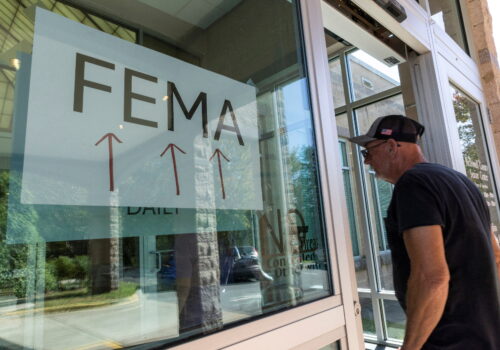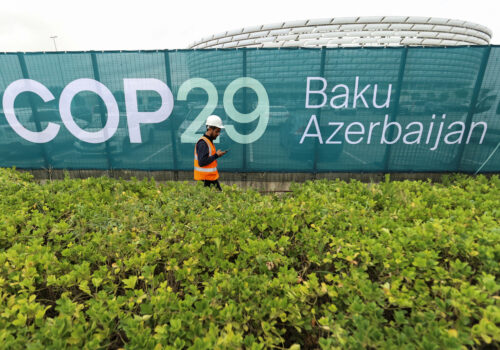As another brutal heat wave hits the US, local and national leaders need to step up
As more than 170 million Americans face a sweltering heat dome that is sending temperatures over 100 degrees Fahrenheit, it’s time to assess the power of effective climate policy and how it could make the United States safer and more prosperous.
Extreme heat is now inevitable. According to data from the National Oceanic and Atmospheric Administration, the United States faced around two heat waves per year in the 1960s. But in the past two decades, this average has jumped to six per year. Heat has disastrous health impacts, decreases worker productivity, and can exacerbate gender inequalities.
If there’s good news amid this heat, it’s that Americans have the information they need to act. For example, look at the heat warnings Americans have received over the past week. Meteorologists have the science and data to predict with a high level of accuracy when heat and humidity will spike. In fact, coverage of the current heat wave started even before it began. However, there’s a gap between knowing these data points and properly resourcing heat preparedness.
In large part, that’s why coordinated city-level heat preparation can keep people safe. Heat warnings might be enough to convince someone to turn on their air conditioning or not go for that midday hike. But these alerts need to be paired with a city-wide response that protects outdoor workers, fortifies supply chains and city operations, and sets up hospitals to not be overrun with patients. And for the elderly, the unhoused, and families who can’t afford to blast air conditioning if they have it, cities need to provide places to cool down and reach these vulnerable populations with medical care.
Now is the time for city officials to consider how to keep people safe.
The Atlantic Council has piloted the role of chief heat officers, partnering with cities to appoint eight of these officers across the world, including in the United States. These chief heat officers have improved and scaled local responses to heat. From launching a tree-planting initiative in Freetown, Sierra Leone, to digitally mapping the coolest, most shaded route for people to walk along on a hot day in Melbourne, Australia, these local leaders are at the forefront of innovative resilience solutions. Even if it isn’t a chief heat officer, having someone at the city level who wakes up every day—even after summer is over—thinking about how to prepare for the next heat wave is essential.
Climate change does not have borders. This most recent heat wave threatened twenty-five states in the United States alone. As Americans face continued and lasting heat, local leaders must recognize this critical opportunity for leadership. While national climate investments have decreased over the past few months, the climate crisis is heating up. Now is the time for city officials to consider how to keep people safe—not wait for the next heat wave before they act.
But this local effort cannot stand alone. Earlier this year, the US retreat on climate under the Trump administration came swift and hard, most notably in the United States’ exit from the Paris Agreement on climate change. But the country cannot afford this retreat. Even at a time when remaining resources are stretched thin, city and state governments—as well as the philanthropic and business communities—must invest in scientific analyses and preventative action that serves communities dealing with the worst impacts of the climate crisis. For local solutions to succeed, they need to be accompanied by the enabling environment and resources to make change happen.
As the effects of this latest heat wave and those to come are broadcast around the world, the costs will become increasingly visible. Now, we must work to ensure that national leaders feel the heat and invest in the solutions that work.
Jorge Gastelumendi is the senior director of the Atlantic Council’s Climate Resilience Center.
Further reading
Tue, Jan 21, 2025
The US retreat on climate comes with steep costs for the economy and the American people
New Atlanticist By Jorge Gastelumendi
Trump's withdrawal from the Paris Agreement will not only hamper global efforts to combat climate change, but also harm Americans' lives and livelihoods.
Fri, Jan 31, 2025
Abolishing FEMA would hurt all Americans—particularly Trump voters
New Atlanticist By Thomas S. Warrick
Instead of abolishing the agency, US President Donald Trump should support fixing its problems, making it more efficient, and changing its focus to include strategic resilience.
Tue, Nov 12, 2024
What Trump’s return as president means for COP29
New Atlanticist By Jorge Gastelumendi
If the United States ends critical climate-related policies and investments, then even more Americans’ health, finances, and safety will be at risk.
Image: Tourists walk outside the United States Capitol Building in Washington, DC, US, on Monday, June 23, 2025. An extreme heat warning is in effect for the District of Columbia, with the heat index expected to top more than 110 degrees by midweek. (Photo by Aaron Schwartz/Sipa USA) REUTERS



